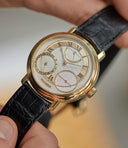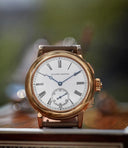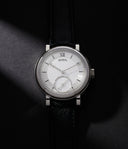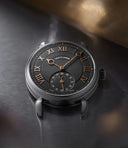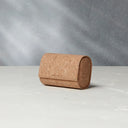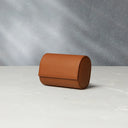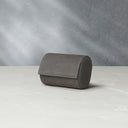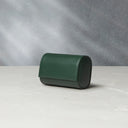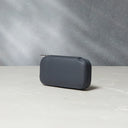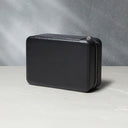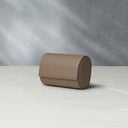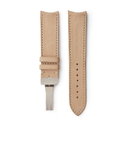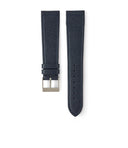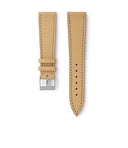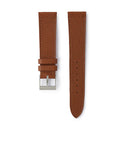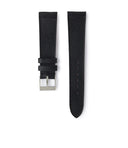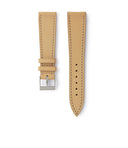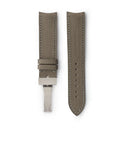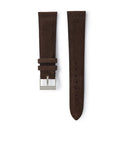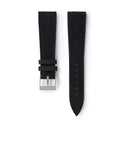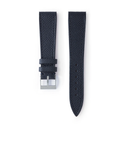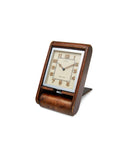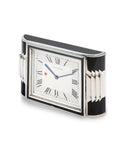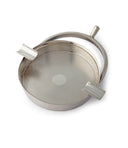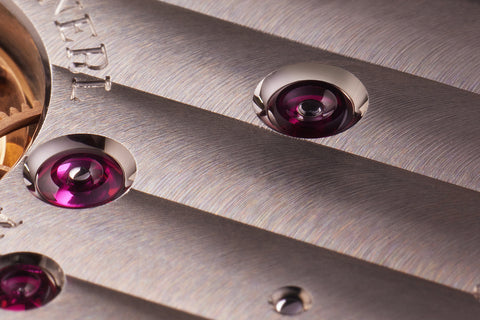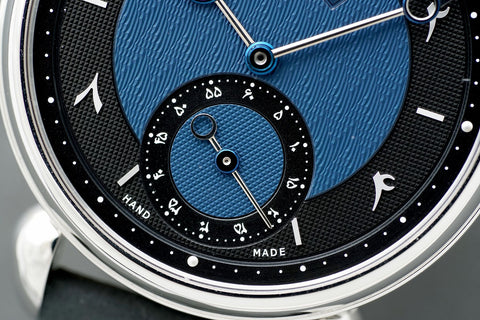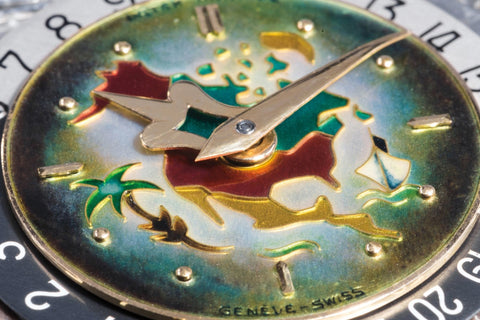

A brief history of Urban Jürgensen
Raj Aditya Chaudhuri
It is not entirely unfounded to refer to Urban Jürgensen – a name with 252 years of provenance – as niche. This is perhaps a function of being born and having evolved in a region of Europe not known for its watchmaking tradition – or the fact that when the brand was resurrected most recently, it pre-dated even the very earliest wave of independent watchmaking.
So is it necessary to appreciate some of this history behind the name to understand the watchmaking it stands for? We believe it might be.
While the brand today is named after one Jürgensen, it is actually a story of many. Some who play a part in its preservation and evolution don’t even share the surname – such as those currently charged with restoring the brand to its place among the great houses of watchmaking.
In this first part of our guide to Urban Jürgensen, we trace the broad arc of the historic brand’s journey from its birth in Copenhagen in the late 18th century to the present day. We examine the 30-year period that helped build the enduring name, and the 30-year span – one-and-a-half centuries later – that reintroduced it to modern consciousness.
By consulting with former owners (such as Dr Helmut Crott) as well as the current ones (including Alex Rosenfield) and watchmakers who have helped carry forward the legacy of the brand in their own way (such as Luca Soprana), we have tried to understand the myriad ways Urban Jürgensen has for so long occupied the imagination of those in the know. For commercial context, we look to the world of auctions (and to Alexandre Ghotbi) through which much of the historically important watches bearing the Jürgensen have passed hands.
In a subsequent edition, we will closely examine the watches most relevant and interesting to the modern context, produced between 1981 and 2010.
Jürgen Jürgensen and his sons
Jørg Jørgensen, born in 1745, started as a watchmaking apprentice at the age of 14, as noted by the then newly instituted Clock and Watchmakers Guild of the city of Copenhagen in 1759. As was customary for apprentices at the time, Jørg had to become a journeyman – a custom of spending a period travelling and learning the craft before an aspiring watchmaker could begin to practise as a member of the guild. Born in a part of Europe not known for its watchmaking tradition, successive generations of Jürgensens looked to the world outside for inspiration.
It is understood that during these travels, which took him to German-speaking regions with a history of watchmaking, that he took on the more Germanic version of his name – Jürg Jürgensen. He would eventually arrive in Le Locle, in the canton of Neuchâtel, which at the time was a Prussian principality. Here he apprenticed with master watchmaker Jacques Frédéric Houriet, a contemporary of Abraham-Louis Breguet and Antide Janvier. (Later on, his eldest son Urban would also collaborate closely with Houriet.)
Copenhagen at the time had a miniscule fraction of the number of practising watchmakers as Geneva, and Jürg came to view the rules of the guild as an obstacle rather than a facilitator for the craft in Denmark. Using the money from the dowry he received as a newlywed, he joined forces with Isaac Larpent, a more senior Norwegian-Danish watchmaker, and the two started producing watches out of a factory they set up near Copenhagen. Circumventing the guild, they applied for a government grant to support the business, which came through in 1781.




No. 2862, created in 1804 – a period when Urban was effectively in charge of the business. It is an 18 ligne quarter repeating calibre, triggered by pressing the pendant pin. It is cased in silver, with an aperture for the winding square. While the period between 1773 and 1814 were marked by four distinct phases and their styles, this particular watch bears characteristics from both the third (marked by French-style movement ornamentation) and the fourth periods (typified by a simple, functional dial and case).
Between 1773 and 1814, about 4,000 pocket watches and clocks were made under the Larpent & Jürgensen brand, underpinned by ébauche calibres sourced from Neuchâtel. Jürgen died in 1811, having created a robust business by marrying well and earning the favour of the Danish crown (he became court horologist in 1785, tasked with maintaining the clocks at Christiansborg Castle). He used royal patronage to secure funding from the state and to advocate for trade barriers on imported watches to protect his fledgling enterprise.
However, Jürgen’s greatest legacy would be the next generation whom he had nurtured. His eldest, Urban, born in 1776, returned to Copenhagen in 1801 from two trips overseas where he had gathered know-how from the three poles of watchmaking – Le Locle, Paris and London. He was ably supported by his younger brother Frederik, whom Urban mentored and who would later go on to take on the family business after Jürgen’s passing. Production during this period continued at a steady pace, with about 100 pieces produced annually, even through periods of conflict with England as well as the economic turmoil that resulted from them.
While Urban’s time in Paris with masters such as Abraham-Louis Breguet and Ferdinand Berthoud was fruitful, it was the months he spent in London – at the houses of John Arnold, and John and Myles Brockbank – that would be the most formative. He found the precision marine chronometers produced in England to be both of a high quality and cost effective – a model he was keen to replicate in his homeland. Needless to say, the Danish crown was very interested in this, having seen the benefits the development of marine chronometers and the conquest of longitudes had brought Britain in terms of trade around the world. It wanted the same for the Danish Navy and merchants.
Like his father before him, Urban learnt from Houriet in Le Locle, and even turned their business relationship into a personal one by marrying his daughter, Sophie Henriette.




Deck watch chronometer No. 56 from 1812. This was produced in a series of eight pieces.
On his return to Denmark, Urban recorded his learnings in Regler for Tidens Nøiagtige Afmaaling ved Uhre (Rules for the Accurate Measurement of Time by Watches and Clocks) – the first practical and general use manual on watchmaking in Danish. It would contain what he had been taught during his years as a journeyman, as well as details on innovations such as his bimetallic pocket thermometers. Encouraged by the Danish crown, the manual was intended to spread his knowledge in the hope that a watchmaking culture would proliferate in the country.
Together Urban and Frederik managed the family’s two workshops quite successfully. Urban travelled again to Le Locle and Geneva in 1807, not returning to Denmark until 1809. On this trip he procured expertise, tools, and a couple of craftsmen who came back with him. This helped him achieve the quality he was aiming for and to scale up production, enabling him to produce not just for the relatively small client base in his home country but for regions including the Ottoman empire and North America.




Urban was perhaps the most ambitious of the Jürgensen clan. His independent vision of technical watchmaking caused him to make under his own name. He was based in the house at number 8 Købmagergade between 1814-1819. Today it houses a Prada boutique. Images courtesy of Urban Jürgensen.
Urban capitalised on his position as the only maker of high-precision marine chronometers and observatory regulators in Denmark (both with Thomas Earnshaw’s version of the detent escapement, as well as his own double-wheel version of the same design), earning royal patronage as well as special privileges. For instance, he became the sole maker of watches with temperature compensation technology and jewelled pivots, and the only one in the country allowed to make pieces without fusée and chain.
He is best remembered for the 45 marine chronometers and six regulator clocks he made, which allowed the Danish Navy to establish colonies in the West Indies, Africa, and South and Southeast Asia. The No. XI, which would go on to be known as the Krusenstern, is probably the best known of the 700 or so watches, clocks and pocket thermometers he produced.
Dr Helmut Crott – an auctioneer, a collector, the one-time owner of Urban Jürgensen and the current guardian of the Krusenstern watch – says, “It is the most important watch ever made by the Jürgensen company. These watches were made for people who were incredibly affluent and a bit technically infected, and helped show off these qualities in the owner. They had a global community that was corresponding about such watches. They would give such watches for a certain expedition, say to Siberia, and when the expedition got back, they’d compare the performance of the 10 watches that went on the trip and decide which was most accurate. To them it was a bit like competing in a Formula One race.”


The first two branches of the Jürgensen name
Urban, always keen to set up his own enterprise, went his own way upon Jürgen’s death in 1811. Frederik was left in charge of the family business and changed its name to Frederik Jürgensen around this time, dedicating himself to fine horology. He was also appointed court horologist, like his father. It is understood that Frederik created about 500 watches and clocks between then and his death in 1843. This branch of the company passed to his son Georg Urban Frederik, also known as Fritz. It remained dormant for many decades and eventually became defunct in 1887.
On Urban’s death in 1830, the business passed to his two sons, Louis Urban and Jules Frederik. Jules Frederik would leave for Le Locle in 1835, starting his own enterprise to create yet another branch of the Jürgensen name. A third surviving son, Frederik (known within the family as Fritz, the Colonel) – who wasn’t a trained watchmaker – took on the running of the company in 1867 after Louis Urban’s passing. Fritz, the Colonel renamed the business Urban Jürgensen & Sønner.
Louis Urban and his son Urban August kept the operation small and focused on innovation and craft, while Jules Frederik created on an industrial scale in Switzerland.




A bimetallic pocket thermometer No. 841, produced under the Louis Urban Jürgensen brand – the third generation of the family. While Urban had created a bimetallic pocket thermometer in 1801, Louis Urban’s innovation furthered it – it could display the highest or lowest temperature as well as the current temperature during a set period of observation. This particular example was produced in about 1846.
Given his lack of interest and aptitude, Fritz, the Colonel passed Urban Jürgensen & Sønner to the company’s then foreman and the brand was sold several times in the early 20th century, leading all the way up to 1977 when the chairman of the Watch and Clockmakers Guild in Copenhagen bought it and used the pieces in the collection to set up a small museum dedicated to its long history in Ny Østergade in Copenhagen’s old town. This is the very museum Peter Baumberger would walk into. Before we get to that chapter of the story, it is worth briefly talking about the other branch of the family, headed by Jules Frederik Jürgensen.
A gradual decline




A J. Alfred Jürgensen Locle from before the two branches of the brand in Switzerland merged under the Jules Jürgensen Copenhagen name. It is possibly one of the earliest examples of a wristwatch to bear the Jürgensen name. As part of Ed. Heuer & Co., the brand would go on to produce wristwatches at the start of the 20th century.
Jules Frederik moved to Le Locle and his company, Jules Jürgensen Copenhagen, produced as many as 15,000 watches. His second son, Jacques Alfred Jürgensen, set up yet another branch, establishing Jacques Alfred Jürgensen Le Locle in 1865. The two concerns would merge under the Jules Jürgensen Copenhagen name just before the start of the 20th century under Jacques Alfred’s stewardship. It remained based in Le Locle.
After Jacques Alfred, the family had no heirs to carry forward the name and it faced a fate much like Urban Jürgensen & Sønner, changing hands several times. Most notably, the Jules Jürgensen Copenhagen brand was acquired jointly by an American retailer for Urban Jürgensen & Sønner and the son of Ed. Heuer & Co., Charles Heuer. Jules Jürgensen Copenhagen would go from one American owner to another, briefly being rebranded Montres Jules Jürgensen.




A pair of Jules Jürgensen pocket watches from the first half of the 20th century. One, No. 17620, is a white gold 45mm case featuring time and calendar complications presented digitally through pumping indications. The watch was made for New York-based retailer and jeweller Udall & Ballou and dates from 1930. The second, embellished with gold enamelling and a likeness of Aphrodite, is the Jules Jürgensen Copenhagen No. 16879. Both are slim, elegant and dripping with the sort of Art Deco details that were in vogue they were created.
The brand was able to gather a following despite its scattered history. Crott says, “I read that in the second half of the 19th century, Jürgensen was the number one [watch brand] in America, before [others such as] Patek Philippe. When Americans came to visit Europe, they went into watch shops and said, ‘I want a Jürgensen’ when they wanted to buy a watch.”
Which Jürgensen brand they were after is unclear to us, as it probably also was to those asking for these watches at jewellery shops in Europe.
This confusing and often legally contentious situation continued till 2012, when the Urban Jürgensen & Sønner and Jules Jürgensen name – then under the stewardship of Crott – became one for the first time since 1835.
“When you compare Jules Jürgensen – complicated watches with minute repeaters, split-second chronographs, perpetual calendars – with English and Swiss ones, they had several different features,” says Crott. “The cases were not as heavy as the English ones and they were not as slim as the Swiss ones. They were just in between and felt really wonderful. The hand setting was special in the Jules Jürgensen watches – you have to pivot the bow in the direction of the dial to set the hands. They also had some of the best enamel dials I can imagine on any watch. The quality of the hands and the movement impressed me very much.”




The intricate art and details of the enamelled caseback of the Jules Jurgensen No. 16879.
A meeting of minds: the Baumberger-Pratt years
Urban’s heyday – between 1800 and 1830 – is rightly viewed as a pinnacle in the family’s history, both in terms of technical advances and the high level of craft he was able to achieve. Another similarly golden era, roughly equal in length, has to be the period between 1979 and 2010, the period of the brand’s first revival. Legend has it that this era began when the vintage dealer and enthusiast Peter Baumberger, dressed in a T-shirt and jeans, happened upon the Urban Jürgensen & Sønner museum in Copenhagen’s old town in the late 1970s.
Despite the attendant rebuffing his many attempts to try to buy the watches on display, Baumberger’s many questions showed an earnest interest and taste. Crott remembers his friend, who he’d known since the mid-1970s, as a cultured and cultivated man, with an eye for special vintage pocket watches. Crott says, “I first met Peter at an auction at Ineichen in Zurich. He was there with a big, wealthy collector client. He was very knowledgeable, and he was very good when meeting people. As a trained watchmaker, he could explain to them why the watch is special and sell them on the quality.”
“Peter and Derek’s philosophy was that if you are a collector for horology, you don’t have much more watchmaking to see and admire than in a pocket watch movement.”
– Dr Helmut Crott
Crott, who went on to set up the auction house Auktionen Dr. Crott, remembers the gentle ribbing he used to get from a much older and more knowledgeable Baumberger. He says, “I was a baby when I met Peter. He always laughed at me when I commented on something he knew about. I was the young novice, and he used to say, ‘You don’t understand anything, you know.’ It was a bit embarrassing at the time.”


Baumberger’s constant companion at the time was Derek Pratt, then a little-known English watchmaker from Orpington, Kent, who had quietly been cutting his teeth in horological micromechanics and microelectronics and had created precise clocks used in black boxes in airplane cockpits. This work had taken him to Switzerland where he also took on one-off commissions to restore antique pocket watches and clocks, which is how he first became acquainted with Baumberger.
Crott remembers meeting Pratt at the same auction in 1975 in Zurich. He says, “I met Derek when he was a consultant to Peter. He came to the sales with Peter to advise him, and he was the one who used to conserve and restore all the watches for Peter. For instance, the Vacheron [Constantin] Grand Complication King Farouk [I] was restored by Derek. He helped Peter estimate how much they’d have to invest to make the watch like new.
“Peter was, as a collector of pocket watches, very much in this world of historical watches and also in this world of quality of finishing. He was somewhat of an idealist, a dreamer. Derek was the one who had to realise the dreams from Peter.”
On matters such as watchmaking technology and craft, they were of the same mind. Crott says, “Peter and Derek’s philosophy was that if you are a collector for horology, you don’t have much more watchmaking to see and admire than in a pocket watch movement.” Their shared interest in horological history could explain the direction their future joint endeavour would take.
The watchmaker Luca Soprana, who has closely studied Pratt’s work and is very close to his family, remembers being in awe when he met him as a student at WOSTEP. He says, “Derek was an absolute legend when we were in school we went to meet him. It was a tradition in WOSTEP – Kari [Voutilainen] brought quite a lot of young watchmakers doing their training, especially those doing the complicated course [to him]. We were fascinated by his craftsmanship and by the fact that he was always trying new things. He was a real experimental watchmaker. He constantly did research on special escapements, which are historical milestones.”
“That’s the nice thing about Derek – he was an artisan in an industrial period.”
– Luca Soprana
Pratt consulted closely with his better-known compatriot, the English watchmaker Dr George Daniels, contributing extensively to the latter’s crowning achievement, the Co-Axial escapement. It is not as well-known that Pratt, owing to his micromechanical skills, created components such as the dual-purpose escape pinion for Daniels’ escapement in his workshop. Soprana says, “Derek has always been extremely discreet, humble, open-minded, very kind – he was absolutely the opposite of George Daniels.”
While Pratt’s tourbillon carriage remontoire is well-known, other innovations such as the Double Wheel Remontoire Tourbillon pocket watch that Pratt created for the Prix Abraham-Louis Breguet in 1997 are equally consequential, Soprana says. As someone who has spent some time bringing Pratt’s Reuleaux remontoire to the world in the Remontoir d’Égalité, Soprana has spent considerable time trying to understand what guided the watchmaker’s innovations.




Images 19 and 20: A ruby Realueax triangle remontoir cam in a Remontoir d’Égalité, crafted by Soprana based on Pratt’s original design.
It is one, he says, that lights the fire in the belly of many a watchmaker. “Derek would get a tool [or] machine that did a specific task, and then he would create something with it,” says Soprana. “Derek got this tool to make oval-shaped pieces on the lathe, and then he made the Oval watch. That was how he thought about stuff. Similarly, in the beginning, the carriage-mounted remontoire tourbillon had cams made from steel. They were performing exactly like the ruby cams that came after. But, of course, the ruby cam was a bigger challenge, so Derek had to try to develop those skills in his workshop.
“That’s the nice thing about Derek – he was an artisan in an industrial period.”
The resurgence of Urban Jürgensen & Sønner
Sensing that this opportunity was a convergence of several personal interests, Baumberger jumped on it. Crott says, “Peter sold his collection of antique watches to finance Urban Jürgensen & Sønner and the new watches, movements, references, and so on.” Crott remembers that from the very start Pratt featured prominently in Baumberger’s calculus to make a success of this venture.
By all accounts, Baumberger’s talents also included a gift of vision and an ability to recognise talent. The industry, in the throes of the quartz crisis, was preparing for wholesale change. Crott says, “Every day, Peter was in the habit of going into the Jura mountains to see his suppliers. During the quartz crisis, when companies put all their hand tools and machines in the street for sale for nothing, Peter bought these up cheaply. He used to laugh about the short-sightedness of these watch executives.”
If these machines, which included engine-turning tools and lathes, were the tools with which Urban Jürgensen & Sønner would be built, Baumberger saw in Pratt the man who could wield them to maximum effect. Crott says, “In the early 70s Derek repaired old watches for Peter. However, Peter was like a mentor for Derek, seeing his obvious skill, and encouraged him to fabricate and make watches.”
Over time, they became close collaborators and friends. Baumberger is thought to have supplemented the many tools and machinery Pratt's fully equipped workshop with those he bought cheaply from his suppliers. Mary Pratt – the watchmaker’s daughter who works as a photography consultant and is based in New York City – spent much of her childhood dipping in and out Pratt’s workshops. The smell of metal, oil, dust and time remains in her nose decades after.
Mary, who felt an online record of her father's work was long overdue, started working on a detailed Wikipedia entry starting Christmas 2024, working with the former editor of the British Horological Institute's Horological Journal and personal friend of Pratt's, Timothy Treffry. Speaking to us, she shared some memories of the intertwined professional and personal lives of Pratt and Baumberger: “Peter was very much a visible presence in the workshop and in our family life as well. Had two sons with his wife Barbara, and those two sons were almost identical in age to my sister and myself. So, there were these two families with two daughters and two sons, and we would do stuff together. Everyone got along well, and they were they were part of our social life – I remember big outings and big Sunday lunches and us kids playing in the park adjacent to this one restaurant that we would go to.”
Professionally, the two had complementary strengths. She says, “Peter was not a mentor to Derek. Derek was as much an artisan as he was an artist and but what he wasn't was a businessman; Peter had a keen instinct for business, and he had a keen eye too. He was a magpie – he recognised beautiful things. What they shared was a love for art and design and quality and unique and original objects.”
Crott thought Baumberger – who was known for being secretive about his work – was remarkably protective of Pratt, going to some distance to keep him from the world beyond the Urban Jürgensen & Sønner workshop. Crott says, “Peter wasn’t an administrator and not skilled at book-keeping [or] marketing. He didn't even have an email address. He had somebody collect the mail in his post box every weekend. This person once told me that he suspected that [Peter would put the mail] straight in the garbage.”
This could be why, though well-intentioned, the brand often struggled to consistently create and execute a serial production of watches, barring a few initial references.
A Reimagined Aesthetic
While Baumberger and Pratt were breathing new life into an old name, they weren’t interested in simply recreating examples from the past. However, their understanding of watchmaking, and Urban’s history, informed the vision for the new watches. By digging into his history, which featured names such as Arnold, Houriet and Breguet among others, they were able to distil aesthetic details that were historically respectful and complementary.
Alexandre Ghotbi, the deputy chairman of watches at Phillips, sums it up succinctly. “In terms of historic Urban Jürgensen and Jules Jürgensen pocket watches, of which there are thousands [of examples], they all have that 18th-century style – enamel dials; heat-blued hands. The modern pocket and wrist watches [from the Baumberger-Pratt years] are more obviously influenced by Breguet – they are classical with delicate guilloché, Breguet/observatoire hands and in elegant sizes.”
Soprana says, “He didn’t have strict guidelines like some older watchmakers have over here, concerned with Geneva or Vallée de Joux style. He was someone who could take from every kind of great watchmaking – it could be German, British, classic Breguet style [or] French style – and … put them all together.”
When the duo set about putting their ideas into practice, their first canvas was a set of vintage ébauches that Baumberger had procured as part of his purchase of the brand.
Crott says, “They had this stock from the old sale of Jürgensen from 1919, when the Swiss branch was sold to Ed. Heuer. Heuer didn’t want to buy the old movements because they thought them too thick. In those days, Art Deco slim watches were in vogue. So Ed. Heuer sold them to the Jürgensen brand in Copenhagen. When Peter bought this Copenhagen branch [Urban Jürgensen & Sønner], he had these movements. With Derek, he had this unique chance to finish them to the highest quality.”


Their belief that watchmaking’s true culture lay in pocket watches undoubtedly led them to the conclusion that this is where this rebirth had to start. This would yield what has come to be known as the 3,000 series of pocket watches created by Pratt in two phases, the first starting in 1981 with the second in the early 1990s.
According to Crott, the brand’s records indicate that it had 70 such vintage ébauche calibres to play with. “They were an assortment of partly blank movements, as well as movements the brand had bought from other specialist companies at the time,” he says. “There was a difference in quality between them. There were probably only 30 to 40 nice, true Jürgensen calibres among them. The most interesting of the 3,000 series of pocket watches were based on these movements.”
While we will discuss the watches produced in this series in greater detail in a subsequent collectors’ guide, it is worth emphasising the level of handcrafting that each of these watches featured, whether Pratt was re-casing old movements that had been stripped for precious-metal cases, or adding complications to vintage ébauches.
Crott says, “Peter had this understanding of historical watches, and he wanted to create these in the way it was done 100 years ago. In Derek he had a partner who could do everything – fantastic dials, hands, movement finishing. However, they gave the watches a very subtle modern touch.”
The pocket watches were in some ways Baumberger’s passion and he was almost reluctant to offer them for sale. Crott says, “Once he had realised a watch, if I wanted to buy it from Peter, it was terrible – it was a fight. He was the biggest lover of his own watches. The photo of Peter with his precious Oval pocket watch sums it up.”
“Peter had this understanding of historical watches, and he wanted to create these in the way it was done 100 years ago. In Derek he had a partner who could do everything.”
– Dr Helmut Crott
The Oval has captured the imagination of collectors and enthusiasts, in part due to its special provenance and story. When Crott finally relented and offered it up for auction via Phillips in 2024, it fetched an astonishing price of CHF 3.7m. In a collecting culture that has over the last few decades been steadily turning away from pocket watches, this was quite the result.
Crott says, “Now, once again the narrative is shifting and people are beginning to talk about how a sophisticated collector of wristwatches should also have one or two or three important pocket watches. This is much like the philosophy Peter had in those days. This is why he created the pocket watches as well as the series of wristwatches in parallel.”
Considering the importance, craft and technology Baumberger and Pratt put in the pocket watches, the watches still represent substantial value. Ghotbi who offered the Oval for auction, says, “You can get these pocket watches – the Oval aside – with a tourbillon with a Reuleaux remontoire system for CHF 100,000-120,000. A comparable wristwatch will cost you three to four times as much. An Urban Jürgensen pocket watch, that is entirely handmade, represents significant value in a space where a modern handmade watch, from a brand such as Greubel Forsey, costs CHF 700,000.”
The Wristwatches
Right from the onset Baumberger was keen to simultaneously produce a small series of wristwatch references made to the same elevated standards of finishing, decoration and detail as the pocket watches, says Crott.
Starting in 1982, the brand produced the Reference 1, a watch that laid down many of the aesthetic codes that would govern almost every subsequent release. Chief among these qualities are the rounded, stepped case, teardrop lugs, and engine-turned dials done with manual tools. The Reference 2, first seen in 1990, added observatoire hands to this modern Urban Jürgensen & Sønner aesthetic. Together with the Reference 3, they represent the archetype of this era. While the Reference 1 featured a Zenith El Primero 410 ébauche – of which Baumberger had the vision to procure a batch in the late 1970s – subsequent watches would feature slim Frédéric Piguet self-winding calibres.


The archetype of the Baumberger-Pratt era Urban Jürgensen – the References 1, 2 and 3, seen below.


These three references were produced in relatively steady – if small – numbers, but this was not the case with references from the latter half of the 1990s. Some were produced in very small quantities, while others were not made readily available for purchase to the general public. Then there were others, with particularly experimental forms, that failed to sell in significant numbers and were commercial failures.
To Crott, this has as much to do with the brand being driven by instinct and passion rather than hard-nosed commercial sense as it does with the fact that the duo was much ahead of the curve. He says, “Peter and Derek with Urban Jürgensen & Søhner [are] what we today refer to as independent watchmakers. This way of doing things simply didn’t exist in the early 80s.”
Together, Baumberger and Pratt created about 700 watches in this period. As with the pocket watches from this era, we will explore each wristwatch reference in more detail in our subsequent collectors’ guide.
This period also saw Baumberger recognise and bring into the fold another talent – Kari Voutilainen. Baumberger was impressed with a tourbillon pocket watch the young Voutilainen had exhibited at the Musée International d’Horlogerie in La Chaux-de-Fonds in 1996. Soon after, Voutilainen started working closely with the brand in a number of capacities, from prototyping to after-sales servicing. It would be an experience that stayed with him, as is evident from the aesthetic he has established at his own eponymous independent brand.


The In-House Pursuit
By the start of the new millennium, Baumberger and Pratt were pursuing their next milestone: an in-house calibre. Enthusiasts of fine watchmaking expected the watches to be fitted with a proprietary movement. The duo wanted such a calibre to also have a historical technical detail. The detent or chronometer escapement, while a mainstay of marine chronometers and high-quality pocket watches owing to the superlative accuracy and longer service intervals it offered, was often viewed as unsuitable for wristwatches. Among other reasons, such an escapement was deemed not able to withstand the shocks of wrist wear. Consequently, it had never been serially produced for this format.
Starting in 2003, Baumberger and Pratt enlisted the help of the watchmaker Jean-Francois Mojon for help with this project. The idea was two versions of a manually-wound calibre – one with a Swiss lever, the other with a detent escapement – that were able to integrate complications (rather than accommodate them modularly) and also have room for a self-winding rotor. Crott says, “Their historical view of watchmaking told them that there had never been a serially produced detent escapement wristwatch, so they managed to get the patent for it.”
Unfortunately, neither Pratt nor Baumberger would see the project come to market. Pratt died in 2009, and Baumberger the following year. In fact, while the plan was to reveal the calibre at Baselworld in 2010, Crott decided the timing wasn’t right. He says, “Peter was depressed about it. The tragedy is, two months later he passed away.”
Crott, who had become a close confidante of Baumberger’s over the years – and had increasingly played a more important role at Urban Jürgensen & Sønner – took over the running of the brand and continued the project with help from Voutilainen. The project was presented in the form of the Reference 11C at Baselworld a year after Baumberger’s death.
Crott, keenly aware of his caretaker role, almost immediately began the process of looking for the right custodian to pass the brand on to. He wanted someone who would respect the heritage the name and carry it on in a thoughtful way.


Crott says, “I did not want to be disruptive. I wanted to preserve the DNA, the reputation and heritage. I wanted continuity both of ideas and values. I remember approaching Swatch, Louis Vuitton [and] Richemont, and while there was a lot of interest, the problem was that Peter had no book-keeping, no records. Today you can sell a company like this on hope value, as is often the case with independents. In those days you had to look at the hard figures.”
Eventually, Crott sold Urban Jürgensen & Sønner to a group of investors headed by Søren Petersen in 2014. Speaking of this era, he says, “In my opinion they brought out some very nice references and they kept the DNA of the brand.” However, the releases from the brand occupied little of the collectors’ imagination over the next few years.
Ghotbi says, “Those who like beautiful watches from independent makers – classical pieces, delicate guilloché, elegant sizes; in short, pieces from the Baumberger-Pratt era – did not relate to these watches from the most recent version of the brand of the past few years. I think a lot of the watches just look like reproductions or larger sizes of existing watches. We didn’t see anything new come out other than the sports watch. I think it lacked some kind of creativity.”
A careful revival
Towards the end of 2021, news started trickling in that a new era for the brand was on its way. Voutilainen would guide the future releases, while the business would be run by the co-chief executive officer Alex Rosenfield.
The latter, who comes from the world of fashion and media, has been around watches from the Baumberger-Pratt era for some time now. “My father [Andrew Rosenfield] is a very involved watch collector and a collector of independent watchmaking,” says Rosenfield. “He began collecting Urban Jürgenson in the late 90s and I always loved those watches and thought they were among his greatest. But it was not the universe I spent time in and neither my father nor I, nor anyone in our family, thought that we would end up owning a watch company.
“For me, as somebody who was a little bit outside of the watch world and isn’t a movement geek in the way that a lot of people are, it’s the beauty of the Derek-Peter watches that drew me to the company and made me love it. The way that they took these techniques that, while they may not have disappeared, were certainly not [in] vogue in the 90s – the frosting, the guilloché and hand enamel and these very classical elements – and breathed new life into them, was remarkable.”
When the opportunity to acquire the brand presented itself, the conversation with Voutilainen was surprisingly straightforward. It was as if the watchmaker had been waiting for just such an opportunity to appear.
“It is a company founded by a Dane – educated by Breguet in Paris and Arnold in London; influenced by watchmakers in Switzerland… I think it’s wonderful how it takes the best of all there is culturally from so many places.”
– Alex Rosenfield
Rosenfield says, “It’s because it’s something he wanted to do. Kari is a businessman and an entrepreneur and is always looking for what will interest and excite him next intellectually. He basically immediately said yes. He wanted to make sure that we understood that he would continue to run and operate Voutilainen and his other businesses and that he had no intention of winding those down, and we never wanted him to. But other than clearing that up, he just wanted to get going.”
So what could the future look like? For starters, the brand will now simply be known as Urban Jürgensen. Voutilainen for his part has made it clear that he is not interested in resurrecting the past, but wants to create something that would be the logical next chapter.
Rosenfield says, “We sort of blank-paged what Urban Jürgensen was when we bought the company, and there were a few through-lines to me – the family through-line, the design through-line. There’s the engineering through-line and then there is what I would call the sort of internationalism of Urban Jürgensen.
“It is a company founded by a Dane – educated by Breguet in Paris and Arnold in London; influenced by watchmakers in Switzerland; who married a Swiss woman [and] moved to Switzerland, but was always a committed Dane. The family moved around, the company moved to America at a point then moved back to Switzerland, where it was designed by a Brit. Now it’s back in American hands, operating in Switzerland with a Finnish watchmaker. I think it’s wonderful how it takes the best of all there is culturally from so many places.”


Parting Thoughts
Trying to digest and present 252 years of history in one article is perhaps a fool’s errand. However, we hope this look at the brand’s expansive heritage has provided an appreciation of what the name Urban Jürgensen stands for – because it is by no means the story of one watchmaker, but of a global village coming together across centuries.
In the next chapter, we will focus on the watches produced between 1981 and 2010. As we have touched upon earlier in this piece, there is considerable innovation and craft within the pocket as well as wrist watches produced in this era, all of them echoing the past we have covered here.
We would like to take a moment to thank Dr Helmut Crott, Kari Voutilainen, Alex Rosenfield, Andrew Rosenfield, Alexandre Ghotbi, Luca Soprana, Mary Pratt and Juliet Haller for their time and insight.
Speak to one our specialists about your Urban Jürgensen here.




























































































